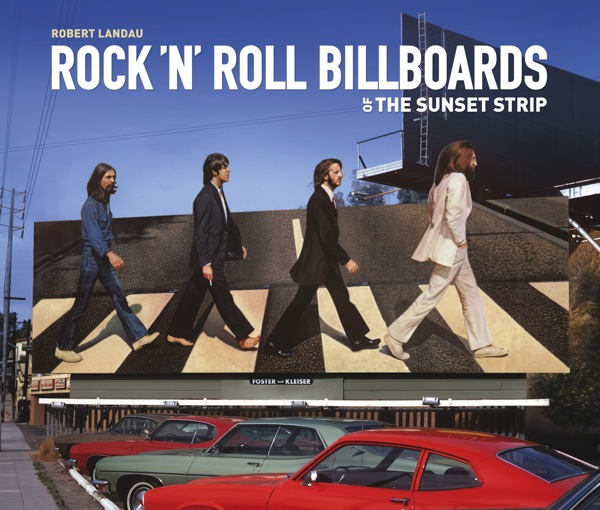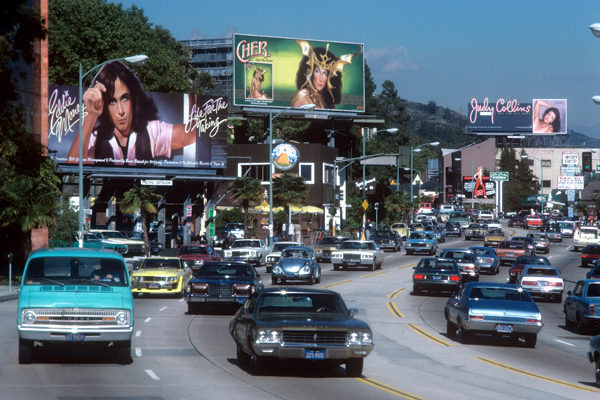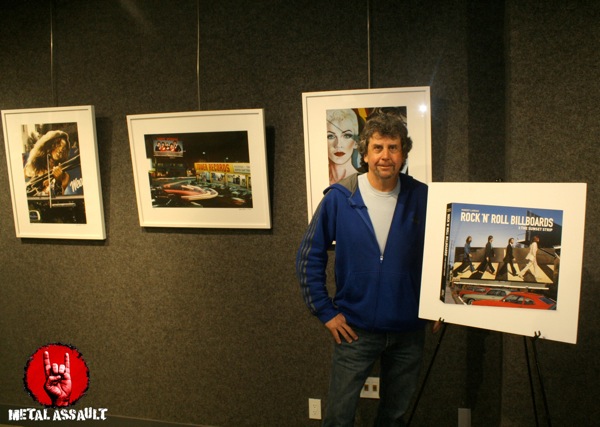By Andrew Bansal
Back in its heyday, the Sunset Strip was a prime spot for giant billboards advertising legendary rock acts. Sadly, that tradition faded away quite rapidly with the advent of the digital age and the decline of the music industry over the past couple of decades, but veteran Los Angeles-based photographer Robert Landau took photographs of these billboards in the 1960s and ’70s, capturing a tremendous volume of history in his collection of photos. He compiled them into a photo book simply titled “Rock ‘N’ Roll Billboards Of The Sunset Strip” and released it in 2012, and is available on Amazon.com and locally in West Hollywood at the Book Soup. On February 19th 2014, at the Gibson GuitarTown media reception, Landau was present with a display of some of his billboard photos, and spoke to Metal Assault about these billboards.
Says Landau of his beginnings as a photographer of billboards, “I grew up a block from the Sunset Strip and I was living on Shoreham, just above where Tower records used to be. This was back in the late 60s and 70s. I’d go out with my camera and there would be a 15-feet high billboard of the Beatles walking across on Abbey Road, just blocks from my home. So I started taking pictures of them, and I realized that these billboards would be up for a month and then they’d just be painted over. They were all hand-painted back then. I knew they wouldn’t be there the next time so I took pictures so I would have them to show to my friends.”
Describing his photo book and looking back at those golden years, Landau explains, “The book starts from 1967 with The Doors, who were the first ones to do it. By the early 80s MTV came along, so all the money that was going into these splashy billboards started going into making videos and it all changed. But for about 15 years there, the Sunset Strip was completely dominated by rock ‘n’ roll billboards, but by the early 80s it was over. So the book is really only about that 15-year span that happened, which just coincides with all the great classic rockers Led Zeppelin, The Beatles, The Rolling Stones, and towards the end there were people like The Arythmics, Blondie and Elvis Costello who came along. But that’s sort of the bookends of it.”
Talking of the disappearance of these rock billboards from the Strip in recent years, Landau says, “For the most part, it’s only a thing of that period. Part of the reason is, everything is digital now and doesn’t have the same look. If you look at these hand-painted billboards closely, they are really well done. They almost look like photographs, but you can see the brush strokes and they are painted by highly trained commercial artists. They just had a different feel and there was a human presence to them that the new billboards don’t have. Plus, they were painted on wood so you could cut them out and extend them off the top, like The Beatles billboard. They are walking across Abbey Road but their heads extend off the top and are outlined by the blue sky behind them. And the other reason is, rock groups can spend their money on making videos. But I must say, Daft Punk saw my book and they got inspired to have their own billboard, so last year they had a billboard on the Strip very much in the style of these classic rock billboards.”
And since these billboards were painted over and replaced regularly, the original versions of the older ones can never be found. “They were painted on wood and you could buy them if you had the money and the place to put them but they were so big that nobody did, so they would just paint the wood over with the next billboard. So The Beatles became David Bowie, which became Rod Stewart. So, if scientists can go in and find that wood, may be you can go back through the layers and find The Beatles in there somewhere. But I don’t know if the wood exists anymore”, says Landau.
In conclusion, Landau sums up this book as “a unique view of a certain period that came and went”, and wants to convert it into a documentary. About this ambition he says, “Since I’ve done a lot of research for the book and talked to a lot of designers, art directors and record company people, one of the things I’d sort of like to do is turn it into a documentary. I think there would be a lot of interesting things that could be captured in a documentary that I couldn’t get in the book. But then I’m a photographer and I’m always shooting Los Angeles and the urban landscape, and that’s what led me to this piece of work.”
Visit Robert Landau on the web:
RobertLandau.com
twitter.com/RobertLandau1
Visit Rock ‘N’ Roll Billboards Of The Sunset Strip on the web:
RockAndRollBillboards.com
facebook.com/RockAndRollBillboards
Order the book on Amazon here.


